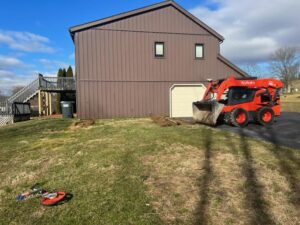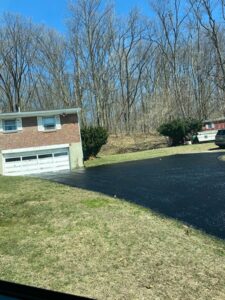Sealcoatin
The Importance of Sealcoating in Winter
Winter is a challenging season for pavement, as the cold temperatures and harsh weather conditions can lead to cracks, potholes, and overall deterioration. This is why sealcoating becomes crucial in winter, as it provides a protective layer that shields the pavement from the damaging effects of snow, ice, and freezing temperatures. By sealing the surface, sealcoating prevents water from seeping into the pavement and expanding when it freezes, which can cause cracks and structural damage. Additionally, the protective coating helps to minimize the impact of deicing chemicals, such as salt and brine, that are often used to keep roadways safe in winter. Therefore, sealcoating plays a vital role in maintaining the integrity and longevity of pavement during the colder months.
Another important aspect of sealcoating in winter is its ability to increase the resilience of the pavement to cold weather. The sealant acts as a barrier against the freezing temperatures, effectively reducing the penetration of the cold into the layers beneath. This helps to prevent the freeze-thaw cycle, where moisture gets into small cracks and expands when frozen, causing the cracks to widen and further damage the pavement. By minimizing the exposure to freezing conditions, sealcoating helps to maintain the structural integrity of the pavement, reducing the chances of costly repairs and replacements. Furthermore, sealcoating can also improve the traction of the pavement, especially when anti-slip additives are included in the sealant, ensuring safer driving conditions during winter.
How Sealcoating Increases Cold-Weather Resilience
Sealcoating plays a crucial role in enhancing the resilience of pavement during the harsh winter months. By applying a protective layer onto the pavement surface, sealcoating acts as a shield against the damaging effects of cold weather. It creates a barrier that prevents moisture, snow, and ice from penetrating into the underlying layers of the pavement.
One of the primary benefits of sealcoating in cold weather is its ability to minimize cracking and damage. Cold temperatures can cause the expansion and contraction of pavement materials, leading to cracks and other structural issues. However, sealcoating helps to seal any existing cracks and prevent the formation of new ones, ensuring the pavement remains intact and resilient. Additionally, sealcoating provides a smoother surface, making it easier to remove snow and ice, and reducing the risk of accidents due to slippery conditions.
Understanding the Effects of Cold Weather on Pavement
Cold weather can have a significant impact on pavement, causing various effects that can be detrimental to its integrity and longevity. When temperatures drop, the freezing and thawing cycles can lead to the formation of ice, which can expand and contract, creating pressure on the pavement’s surface. This constant expansion and contraction can induce stress and eventually lead to cracks and potholes. Additionally, the use of de-icing salts and chemicals can also contribute to the deterioration of pavement, as these substances can seep into the cracks and weaken the underlying structure. In colder regions, it is crucial to understand the effects of cold weather on pavement and take proactive measures to mitigate any potential damage.
One of the primary effects of cold weather on pavement is the development of cracks. The repeated freezing and thawing cycles can cause the pavement to contract and expand, leading to the formation of cracks. These cracks not only compromise the aesthetics of the pavement but also serve as entry points for water and other corrosive materials. Over time, if left unaddressed, these cracks can widen and deepen, increasing the risk of potholes. Furthermore, the use of de-icing salts to combat icy conditions can exacerbate the damage by further weakening the pavement’s structure. Therefore, understanding the effects of cold weather on pavement is essential for implementing effective preventive measures to minimize potential cracks and damage.
• Freezing and thawing cycles cause pavement to contract and expand, leading to cracks
• Cracks serve as entry points for water and corrosive materials
• De-icing salts weaken the pavement’s structure, worsening the damage
• Implementing preventive measures is crucial in minimizing cracks and damage
Preventing Cracks and Damage with Sealcoating
Sealcoating is a valuable preventative measure that can help to prevent cracks and damage to pavement during the winter months. By applying a protective layer to the surface of the pavement, sealcoating helps to create a barrier against the harsh elements that can wreak havoc on the integrity of the pavement.
One of the main benefits of sealcoating is its ability to seal small cracks and prevent them from expanding. During the winter, freeze-thaw cycles can cause water to seep into even the tiniest cracks in the pavement. When this water freezes, it expands, creating additional stress on the pavement and leading to larger and more damaging cracks. Sealcoating provides a protective layer that prevents water from seeping into the pavement, reducing the risk of cracks and extending the lifespan of the pavement.
The Role of Sealcoating in Extending Pavement Lifespan
Sealcoating plays a crucial role in extending the lifespan of pavement. By forming a protective barrier, sealcoating shields the surface from various damaging elements such as UV rays, chemicals, and moisture. Over time, exposure to these elements can cause the pavement to deteriorate, leading to cracks, potholes, and overall structural weakness.
Regular sealcoating maintenance helps to prevent these issues and preserve the durability of the pavement. When applied correctly, sealcoating helps minimize water penetration, which is a major cause of pavement damage. It also acts as a barrier against harsh winter conditions like freezing and thawing cycles, which can further contribute to cracking and degradation. By investing in sealcoating, property owners can significantly extend the lifespan of their pavements, saving time and money on costly repairs and replacements in the long run.
Choosing the Right Sealcoating Materials for Winter Conditions
When it comes to choosing the right sealcoating materials for winter conditions, there are several factors to consider. The first is the type of pavement you are working with. Different pavements have different needs and require specific sealcoating materials to withstand the harsh winter elements. For example, asphalt pavements may benefit from a sealcoat that contains polymers, as these additives can enhance the flexibility and durability of the sealcoat, reducing the likelihood of cracking and damage.
Another important aspect to consider is the climate in your area. If you live in a region with extreme winter weather, such as heavy snowfall or frequent freeze-thaw cycles, it is crucial to select a sealcoating material that can withstand these conditions. Look for products that have a high resistance to water penetration and can effectively protect the pavement from the damaging effects of ice and snow. Additionally, consider the curing time of the sealcoat, as faster drying products are often more suitable for cold temperatures. By carefully evaluating the specific needs of your pavement and understanding the challenges of your climate, you can make an informed decision when choosing the right sealcoating materials for winter conditions.
Sealcoating Techniques for Cold-Weather Application
In order to maximize the effectiveness of sealcoating during the cold winter months, it is important to employ specific techniques for cold-weather application. One key technique is to ensure proper surface preparation before applying the sealcoat. This involves thoroughly cleaning the pavement to remove any dirt, debris, or loose particles. Additionally, any existing cracks or potholes should be repaired prior to sealcoating to prevent further damage.
Another important technique for cold-weather is the use of specialized materials that are designed to withstand freezing temperatures. These materials are typically formulated with additives that help them cure and dry faster in colder conditions. Additionally, cold-weather techniques often involve applying thinner coats of sealant to allow for quicker drying times. This helps to ensure a properly sealed surface that can withstand the harsh winter weather conditions and extend the lifespan of the pavement.
The Benefits of Regular Sealcoating Maintenance in Winter
Regular sealcoating maintenance in winter brings numerous benefits to pavement surfaces. Firstly, it serves as a protective barrier against the harsh weather conditions that winter brings. The freezing temperatures, snow, ice, and salt can all take a toll on the pavement, causing cracks, potholes, and deterioration. By regularly the pavement, the layers act as a shield, preventing moisture and chemicals from seeping into the pavement and causing damage. Additionally, It helps to maintain the appearance of the pavement, keeping it looking fresh and well-maintained even in the winter months. This enhanced aesthetic appeal not only improves the overall visual appeal of the area but also creates a positive impression for visitors and passers-by.
Moreover, regular sealcoating maintenance in winter extends the lifespan of the pavement. By creating a protective layer, it helps to reduce oxidation and prevent the formation of cracks and potholes. These cracks can worsen over time, leading to costly repairs if left unaddressed. Furthermore, It also helps to preserve the structural integrity of the pavement, preventing the need for major reconstruction or resurfacing. With regular maintenance, the pavement remains intact and durable, saving both time and money in the long run. Overall, the investment in regular sealcoating maintenance during winter proves to be highly beneficial, protecting the pavement from damage and ensuring its longevity.
What is sealcoating?
it is a protective layer applied to asphalt pavements to protect them from damage caused by weather, UV rays, and traffic.
Why is sealcoating important in winter?
it provides an additional layer of protection against the harsh effects of cold weather, such as freezing and thawing cycles, ice, and snow.
How does sealcoating increase cold-weather resilience?
it helps to prevent water penetration into the pavement, which can cause cracks and damage during freezing and thawing cycles in winter.
What are the effects of cold weather on pavement?
Cold weather can cause asphalt pavements to contract, leading to cracks and other forms of damage. The freeze-thaw cycle can also cause the pavement to deteriorate more quickly.
Can sealcoating prevent cracks and damage in winter?
Yes, It acts as a barrier against water infiltration, reducing the likelihood of cracks and damage caused by freezing and thawing cycles.
Does sealcoating extend the lifespan of pavement?
Yes, it can significantly extend the lifespan of pavement by protecting it from various forms of damage, including those caused by cold weather.
How do I choose the right sealcoating materials for winter conditions?
It is important to select it materials that are specifically designed for cold weather conditions. Look for products that offer enhanced flexibility and durability in low temperatures.
Are there specific techniques for cold-weather application?
Yes, cold-weather sealcoating requires careful consideration of application techniques. It is recommended to apply the sealcoat during periods of dry and mild weather to ensure proper curing.
What are the benefits of regular sealcoating maintenance in winter?
Regular maintenance in winter helps to prevent cracks, damage, and deterioration of the pavement. It also helps to extend the lifespan of the pavement and reduce repair costs.


